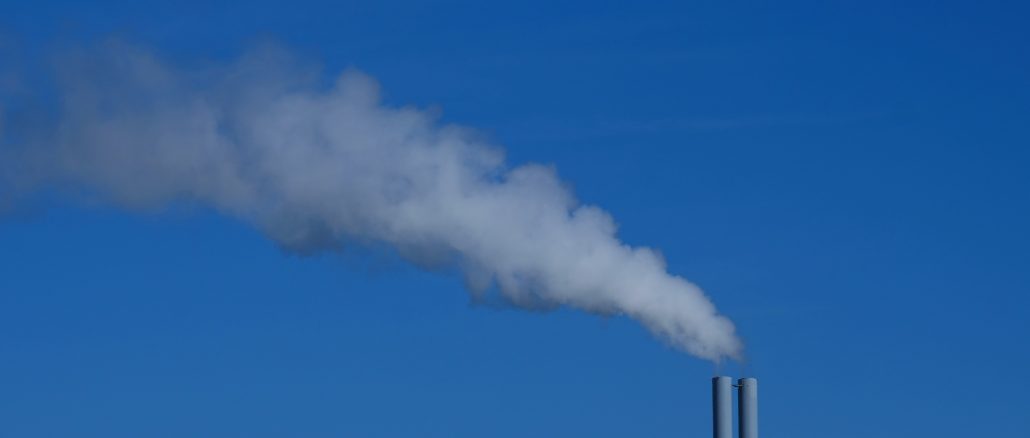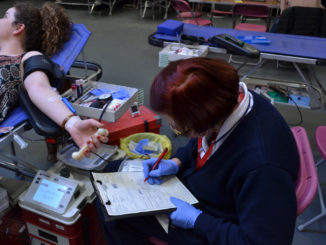
[dropcap]E[/dropcap]very evening, as the sky turns dark and the wind becomes bitter, Jenny looks out of her living room window to see her son playing outside.
She knows he will have to come inside sooner than his friends, it’s just not safe for him to stay outside when it gets this late.
“I do find that when the evenings get darker, if Charlie is out past five o’ clock and the neighbours are lighting their fires, he’s in a bad way coming back in,” she says.
Jenny is a nurse living in Cork. Two of her children are asthmatic. Inside her zoom screen, she points at her youngest son who can be heard playing in the house just out of frame.
“He’ll definitely be in a bad way, usually he’s gasping for breath by the end of the night. So, I’m looking at my watch and I’m like ok it’s five past five he has to come in off the road or he’s going to have a bad night. And I know it’s definitely the fires, as well as the cold air, but I think mostly the smoke and the fires around the place catch him,” she says.
When asked if many families would light fires where she lives, she just laughed and answered:
“Oh yeah, I think nearly most of them would.”
The burning of solid fuels has a long history in Ireland, with winter smog being a mainstay of urban life throughout the country until the ban of “smoky coal” fuel sources in 1989, a ban which has since resulted in air pollution levels falling by 70 per cent and an estimated 8,000 fewer deaths from heart and lung-related diseases.
Despite this ban, air pollution has been a constant issue as Ireland continues to strive towards using sustainable energy and lowering harmful solid fuel emissions, particularly in the household.
As we face another lockdown, and families are isolating at home during the cold winter nights, the conversation around the ways in which Irish people heat their homes again becomes relevant.
The health impacts of air pollution
The world was given a horrific reminder of the realities of air pollution this month when a coroner in the UK reported that the death of a nine-year-old girl in 2013 was the result of “asthma, contributed to by exposure to excessive air pollution.”
She was believed to be the first person in the UK to have air pollution listed as the cause of death on their death certificate.
These stark effects of air pollution on public health can be seen in Ireland as well.
“Poor air quality is estimated by the European Environment Agency to have caused 1,300 premature deaths in Ireland in 2017,” says a representative from the air department of Irish Environmental Protection Agency, who went into further detail on the health effects of air pollution.
“Poor air quality has both short term and long-term health implications. Short term health implications include headaches, breathing difficulty and eye irritation. Long term implications include both development of and triggering of asthma, cardiovascular impacts and reduced liver function.”
For people suffering from asthma, this can manifest in increased instances of flare-ups and asthma attacks during the winter months, where air quality is at its lowest due to increased traffic and the burning of solid fuel sources at home.
“The summer is great for them, they barely need their inhalers,” Jenny explains when asked about at what points in the year are her children’s flare-ups particularly bad. “As soon as they go back to school in September until about April, they are pretty bad. So the winter is definitely bad for them.”
Jenny tells about how after a particularly hard winter, her youngest son Conor had a major flare-up that sent him to the hospital.
“He was about two and a half and he got really, really bad. He was put on antibiotics and steroids and he got no better. We were pumping him full of inhalers, you could see by his chest that he was struggling really badly.
“I brought him to the GP and they sent him straight in. She said it might be a bit dramatic to call an ambulance because it might panic us, so she just said get him to the hospital straight away.
“He ended up in for a week, he had really bad pneumonia. So that was pretty scary, now that was probably one of the most frightening incidents because no matter what we gave him he couldn’t catch his breath, he couldn’t slow his breathing. In hospital he was on oxygen every night because his stats were quite low. That was probably the most scary instance we’ve had with the boys.”
Continued exposure to air pollution can lead to adults developing asthma later in life, as was the case with Charles Fielding, a retired bank manager who worked in Dublin for most of his life, Dublin being the county with the highest levels of air pollution in Ireland consistently.
“When it does flare up,” Fielding tells over the phone, taking deep breaths in between sentences as he has just gotten back from a round of golf, “I’m totally caught for breath, a shortness of breath, lack of energy, but I suppose as I got older I kind of grew out of it slightly,”
“Then it kind of flared up again in later years. I’m on a preventative and an asthma spray now, but for most of my life after my thirties I’ve been killed with it.”
Fielding attributes air pollution as a factor in his late-onset asthma, and there are many instances he can remember where air quality triggered flare-ups.
“There was one when I was going to work, in the bank. It was in the city, when a load of ships used to come in at the harbour. They’d be unloading some kind of fertiliser or something like that. Fumes were going up into the air.
“That morning when I got into work I got an awful asthma attack. It was only afterwards, and I read about it in the paper, I learned about the release of dust from the fertiliser into the air, from the unloading of the boat and whatever way the wind was blowing. A lot of people complained about getting caught in the chest and stuff like that,” he said.
These experiences of a handful of Irish people with pre-existing conditions, only show a small piece of the total impact of air pollution on public health.
If we zoom out our focus, we can begin to see the reality, which is that air pollution is the largest environmental cause of poor health worldwide, and its effects will only get worse as it quickens the pace of global warming.
“When you start looking at these statistics overall for the impact of lower air quality, the numbers are really staggering,” says Dean Venables, an air quality and atmospheric scientist at University College Cork (UCC),
“In Ireland, the estimated number of premature deaths attributable to air quality is about 1,300 per year. If you compare that to traffic mortality, which gets a lot of attention because they’re big traumatic events which take away life very quickly and suddenly, they only cause about 150 deaths per year in Ireland.
“So, we’re speaking about something that’s about 8-10 times larger in terms of overall impact and that’s in terms of mortality,” said Venables.
“Therefore, from a public health perspective it’s really, really important. Air quality is by far the largest environmental cause of poor health around the world. The worldwide figures vary but we’re certainly looking at about 5-7 million premature deaths per year owing to air quality,” he said.
While air pollution can aggravate pre-existing respiratory conditions, it can also impact a number of other serious life-threatening illnesses.
Researchers from the Royal College of Surgeons in Ireland reported in August that there was a statistically significant rise in the number of hospitalisations for strokes in Dublin zero to two days after a rise in air pollution.
Higher levels of fine particles in the air, resulting from the burning of solid fuel, correlated with a 2.4 per cent higher risk of hospitalisation from strokes.
Causes of air pollution
While it is now evident that air pollution is a significant health issue in Ireland, it is important to understand the factors that lead to the pollution of the air in the first place.
Stig Hellebust, a specialist in the identification and quantification of air pollution sources at the Environmental Research Institute in UCC, outlines what these factors are:
“From our own research, much of which would be funded by the EPA, we have seen that the major sources of common air pollutants like particulate matter and nitrogen oxides in Ireland are solid fuel burning, that would be coal, peat and wood, as well as fossil fuel combustion, which would mostly be a result of vehicle traffic. Solid fuel contribution would exceed that of vehicle traffic in most locations outside of Dublin City Centre.”
Climate change and the ‘smokey fuels’ ban
Turf and bituminous coal rank as the most damaging heat source in Irish households. Venables says that the burning of these particular solid fuels “is producing a lot of carbon dioxide and has been adding to the problem of climate warming for years.”
He explains that the particulate matter that these fuel sources produce, on top of being the largest cause of poor impacts in terms of public health, are doing significant damage to our atmosphere:
“Particulate matter is interesting because it attempts to cool the atmosphere rather than warm it up over a relatively short period of time. However, depending on the composition of these particles, there is also a warming effect.
“These emissions into the atmosphere affect the earth’s energy balance, which is how energy from the sun is absorbed in the atmosphere or reflected out into space.”
The impact of the burning of these solid fuels on both public health and on the ongoing crisis of climate change is not new information to the Irish government. However, Venables feels that the severity of the issue is not reflected in the government’s preventative measures.
“I feel like how serious the problem is isn’t appreciated by politicians.” he said.
“You really ought to have removed any possibility of solid fuel combustion. It’s taken a long time to get these solid fuel bans in place for various reasons. But given how serious the matter is these really should have been brought forward much sooner.”
In 2020, the Irish government announced a ban on the burning of all bituminous and other specified fuel in all towns and cities in the country with a population of more than 10,000.
These areas were to be deemed “low smoke zones,” with the ban to come into effect from September 1st, 2020.
In the months since the ban came into effect, those like Jenny who are living in low smoke zones say that a notable improvement in air quality, or any sort of enforcement on the ban, has not been seen.
“We were in one of the zones I remember they were supposed to be banning all these types of fuel down here,” Jenny recalls, “well, they were meant to anyway, I don’t think it’s ever been enforced, and people don’t stick with it. I definitely know my father-in-law doesn’t *laughs*.”
Improving the quality of air in Ireland is absolutely imperative to both protecting public health, and to protect our atmosphere and environment to negate the continuation of global warming and harmful climate change.
Venables outlines how things can get better in Ireland, and that we are already on the right track.
“Things like housing stock is improving, every house now has a boiler or a heat pump. But they may still have stoves, so the real problem is this sort of habitual behaviour we do that really impacts our air quality.
“I think what we need to do is acknowledge that things are getting better, but we also need to see the government working even more intentionally to discourage solid fuel burning. That could be in a range of measures including much higher prices for coal and peat and so on.”
Thomas Hamilton
Image Credit: Ria Puskas on Unsplash



